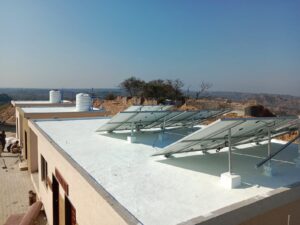What kinds of materials are used to keep water out of a roof?
How strong a building depends on what materials were used to build it and how well it is protected from weather damage. Some things, like waterproofing and heat-proofing systems that can handle sudden changes in the weather, also affect how strong and stable a building is. Water seepage is a real problem, and if you don’t buy some good waterproofing materials, it can easily weaken the foundation of a house. We’ve made a list of different waterproofing materials in Pakistan and what they’re used for so you can make an informed choice.
To protect roofs from rain and snow, and get services from Waterproofing in Jhelum, it is important to use the right insulation materials. When it comes to roof insulation, it’s also important to ask which waterproofing membranes you should use.

Chemical injections that don’t leak
Most of the time, this is used to fix up homes. It is a thick injection resin that fills cracks and holes in your concrete structure to keep it waterproof. This method of Roof waterproofing in Jhelum also works in places like basements where you can’t reach the outside walls. The area where the polymer was injected becomes stronger than the wall next to it.
There is also a chemical grout injection Waterproofing company, which is used when there are too many cracks to fill one at a time. Through a wall, a waterproofing grout that expands is injected into the backside of the surface. When the chemical grout meets water, it grows to many times its original size. If it doesn’t meet water, the grout won’t do anything until it does. Then let’s get going.

Pakistan Has Many Different Types Of Waterproofing Materials
You should think about waterproofing your home, whether you are building it from scratch or fixing it up. It rains often or where there is a lot of humidity, which lets water seep in and weakens the foundation of your home. Also, it makes it easy for mould and mildew to grow quickly, which not only looks bad but can also hurt your house’s structure. So, it’s important to spend a little on waterproofing your home so you don’t have to spend your hard-earned money fixing structural damage that can’t be fixed. Here are the different types of waterproofing materials you can use in Pakistan, based on where you want to use them. In this blog, Master Roof treatments will also talk about how to use and apply them.
WATERPROOFING WITH CEMENT
There are a lot of waterproofing materials in Pakistan, but cementitious waterproofing material is by far the most reliable on concrete surfaces and in places where water seepage and seepage problems are common.
Cementitious membranes Leakage solution Jhelum have been used to protect places that stay wet for a long time and don’t have much water pressure. These waterproofing membranes are used to keep water out of water tanks, bathrooms, swimming pools, the walls of a basement, and the floors of wet rooms like bathrooms.
Some of the benefits of cementitious waterproofing membranes include their resistance to water, even if they are always exposed to it, like in a bathroom where the floor is always wet. What sets apart from other waterproofing materials is that it can handle long-term weathering, heavy loads, and scratches better than anything else.
Roof Repairing
Most flat roofs, basements, retaining walls, terraces, bridges, underground structures, and flat roofs are made with torch-applied bitumen membranes. One of the best things about torch-applied bitumen membranes is that they are very resistant to damage from water and chemicals. Even though the installation process isn’t hard, it is not recommended that you do it yourself. Instead, you should hire a professional. To put the bitumen membrane on the roof, you need the right tools, such as a torch. The surface should be kept clean and free of dirt.
Check the connection of Master Roof treatments to the torch and make sure the torch is on the lowest setting possible, or it will burn things up. When you put down the bitumen membrane, there shouldn’t be any gaps. Apply the torch fire slowly and evenly over the membrane to make sure there are no gaps. When putting the membrane down near joints, you should be extra careful.
When the bitumen membrane comes to an end, it needs to be overlapped about 3 inches on all the sides and 6 inches at the end to keep its grip and keep water and moisture from getting through.
Bitumen
The hot melt bitumen membrane is in the form of a solid block. It is modified bitumen made with polymers. The block is then heated and put on the roof structure. This protects it right away from water and moisture. It can be used to waterproof the roof, garage, deck, foundation, and roads, among other things.
A liquid bitumen membrane that is put on with cold methods is usually used for homes. You don’t need to heat the membrane or use a torch or flame on it. It can be put in place safely, and it can also seal cracks. It is a common way to waterproof areas of the ground that are prone to getting too wet or letting water seep through. This bitumen waterproofing material can be used by yourself and is great for swimming pools and other wet places.
Self-adhesive bituminous membranes have a liner that is easy to remove when it’s time to put them in place. This is a great for people who want to do it themselves and waterproof their home from Master Roof treatments. But this works better for smaller areas and not so well for the whole roof. You can use it to waterproof wood structures, basements, retaining walls, and any areas where the torch-applied bitumen membrane can’t be used, like fireplaces or rooftop barbecue areas.
